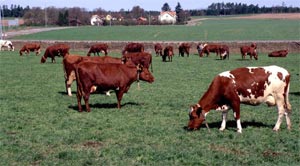Type the name of the breed you're looking for below
[wpdreams_ajaxsearchlite] Don't see the breed your're looking for? Click here and let us know!
Swedish Red cattle
| Place of Origin | Sweden |
| Origin | Swedish Red Cattle, (SRB) also called Swedish Red-and-White Cattle, (in Swedish: Svensk rödbrokig boskap or Svensk röd och vit boskap) are a dairy cattle breed from Sweden that originated from English Milking Shorthorn dairy cattle and Scottish Ayrshire cattle. In the 1920s, the Red Pied Swedish Breed (RSB) was largest in terms of size in Sweden, but merged with the Swedish Ayrshire Breed in 1928, forming the SRB breed. Over the last five decades, genes of red breeds in Scandinavian countries are being incorporated into the SRB breed as a part of a joint breeding program. This breeding program involves incorporating red dairy genetics from Sweden, Finland, and Denmark, as well as from the Norwegian Red (NRF) breed. |
| Purpose | They are a multi-purpose breed, used primarily for dairy, with some potential in meat production. |
| Appearance | Swedish Red and White are medium sized cows, and are mostly red with patchy white spotting. They are approximately 140 cm tall. |
| Horns | Either small horns or polled (hornless) |
| Cows Average Weight | 500 kg (1,102 lbs) |
| Bulls Average Weight | 600 kg (1,323 lbs.) |
| Other Considerations | They give approximately 8000 kg of milk per year, with a fat content of 4.4%, and a protein content of 3.6%. Current status; Crossbreeding of Swedish Red with other breeds is popular in other countries and continents, especially with the Holstein breed in North America. Reoccurring problems in the Holstein breed are calving difficulties, high Somatic cell count (SCC), fertility, and longevity. These problems could be a result of breeding programs which are overly focused on high production. To combat these problems, Swedish Red genetics are being incorporated into North American Dairy herds. Another factor playing a role is the changing of milk pricing in both the United States and Canada. This is due to the Multiple Component Milk Pricing adopted in January 2000. Instead of being paid a flat rate for the amount of milk produced, the milk components will be assessed and milk cheques based on the amount and quality of these components. Swedish Reds have a higher protein and fat content than purebred Holsteins, furthering the incentive for North American producers to incorporate these genetics into their herds. Despite their popularity in North America,‘Holsteinization’ of breeds is becoming increasingly common in Sweden. For example, the Swedish Friesian, Svensk Laglandsboskap (SLB) now known as the Swedish Holstein, is a direct example of this. Due to a lack of competition production wise between the original SLB when compared to the North American Holstein, the proportion of North American Holstein genetics are steadily increasing in this particular type of cattle. In 1975, the proportion of these genes in Swedish cattle was only 6%. In 2005, it has increased to over 90%. |



